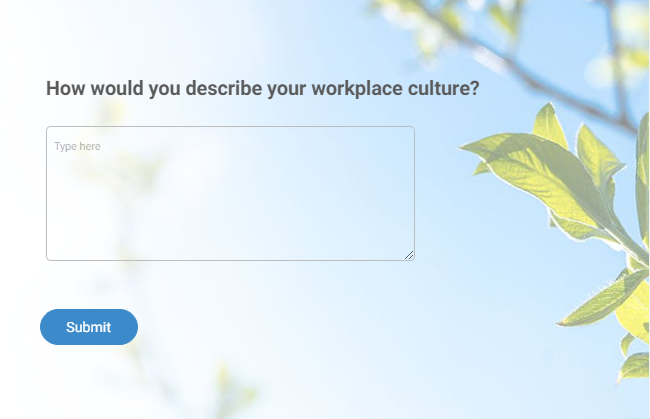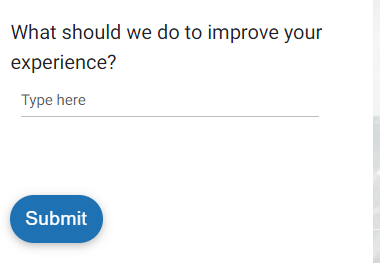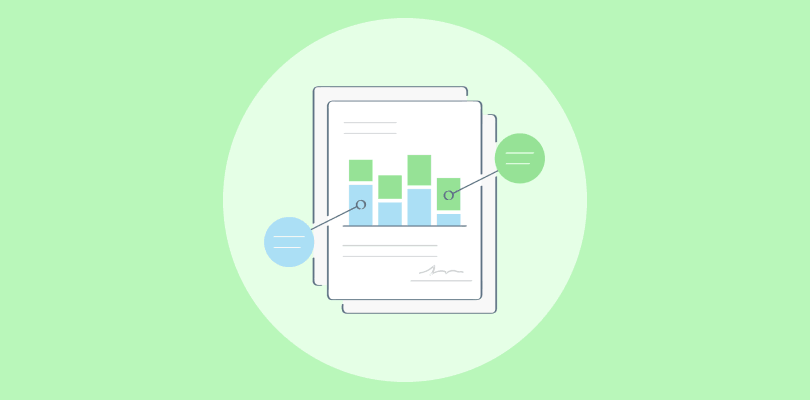
Imagine you are having a conversation with a friend. To find out how they are, do you hand them a list of yes/no or multiple-choice questions? No. You ask and let them describe their experience in their own words.
This is the essence of using open-ended questions in surveys. When you let people answer queries freely, it can transform a mundane Q&A into a meaningful dialogue and reveal insights that simple checkboxes cannot capture.
While close-ended questions are certainly useful for obtaining quantifiable data that you can work with, open-ended questions are the gateway to understanding peoples’ true thoughts, feelings, and stories—essentially, the why behind the whats.
This detailed guide will answer all your doubts about open-ended questions, what they are, how they can be used, strategies, and example questions.
Watch: How to Create a Survey Using ProProfs Survey Maker
What Are Open-Ended Questions?

Open-ended questions allow respondents to answer the query in their own words. They may or may not come with strict word limits and can be used can be used alone or alongside other closed-ended options.
They invite people to share more detailed responses, such as their thoughts, feelings, and experiences. For example, instead of asking, “Do you like this?” you might ask, “What do you like about this?”
In a business context, open-ended questions can be incredibly valuable. They help you gain deeper insights into customer preferences, identify areas for improvement, and understand the motivations behind customer choices.
What Are Some Benefits of Using Open-Ended Questions?
Open-ended questions offer several key benefits in surveys, including rich and detailed data, improved response rates, increased engagement, and the ability to identify patterns.
These questions can be particularly useful for qualitative research, where the focus is on understanding the experiences and perspectives of the respondents.
This is how:
1. No Restrictions or Word Limit
Open-ended questions allow respondents to decide how much information they wish to reveal. They offer greater flexibility in the answers collected, making it easier to adapt to the needs of the topic being investigated.
2. Richer Data Collection
Open-ended questions engage respondents in a more meaningful way, encouraging them to think deeply about the topic. This can lead to more invested and attentive respondents, resulting in improved quality of collected data.
3. Improved Accuracy
Closed-ended questions may not always accurately gauge thoughts. In contrast, open-ended questions enable respondents to provide more nuanced and complex answers, leading to a more precise representation of their experiences and opinions. They also eliminate the risk of respondents not having enough knowledge to choose from pre-defined answers.
4. Make Respondents Feel Comfortable and Valued
People are more likely to participate in a survey if they feel their opinions and thoughts are valued and considered. Open-ended questions offer this opportunity, which can improve response rates in surveys.
5. Obtain Unpredictable Responses
Open-ended questions allow respondents to bring up new ideas and perspectives that may not have been considered previously. This can lead to more thoroughly exploring the topic and uncovering new insights.
6. Elicit Valuable Information
Open-ended questions allow respondents to provide more information and detail than closed-ended questions. This can lead to a richer understanding of the topic and valuable insights into the respondents’ attitudes, experiences, and thoughts.
7. Solve Complex Problems
Complex issues or topics may not be easily understood through closed-ended questions. Open-ended questions allow respondents to express their thoughts and opinions in their own words, leading to a more comprehensive understanding of complex issues.
8. Identify Patterns
The detailed data obtained from open-ended questions can be analyzed to identify patterns and themes, providing valuable insights into the topic. This can be particularly useful for qualitative research, where the focus is on understanding the experiences and perspectives of the respondents.
When Should You Use an Open-Ended Question?
Open-ended questions can be used in various instances. Whether you are looking for detailed feedback on a particular product from your customers or more insight into the target market, there are a number of cases where it is better to ask open-ended questions.

Instance 1: Following Up
Open-ended questions are great for following up on closed-ended questions. They allow respondents to elaborate on their initial answers, providing more depth and insight.
Instance 2: Getting More Context
When you need more detailed and contextual answers, open-ended questions are invaluable. For example, after an NPS survey, asking, “Why did you give this rating?” helps you understand the reasoning behind the score and identify areas for improvement.
Instance 3: Understanding Emotions
Open-ended questions can reveal how customers truly feel about your product or service. By analyzing the language, word choice, and tone, you can gauge their emotions and sentiments more accurately.
Instance 4: Addressing Complex Situations
In complex scenarios, such as customer support, open-ended questions can help gather comprehensive information. They allow customers to explain their issues in detail, which is crucial for effective problem-solving.
Instance 5: Initial Discovery
Open-ended questions are essential when building new connections or gathering qualitative information. They help you understand prospects’ needs and preferences, setting the stage for better future interactions.
Instance 6: Encouraging Creativity
Open-ended questions allow respondents to think creatively and share innovative ideas. This can be particularly useful in brainstorming sessions or when seeking feedback on new product concepts.
Instance 7: Identifying Trends
By allowing respondents to speak freely, open-ended questions can help identify emerging trends and common themes that might not be evident through closed-ended questions alone.
What Are Some Examples of Open-Ended Questions
Looking to get started with including open-ended questions in your surveys? Here are some of the most effective examples of open-ended questions that you can use.
A. Based on Industry-Based Use Cases
1. Retail
- What do you enjoy most about shopping at our store?
- How can we improve your shopping experience with us?
- Can you describe a memorable shopping experience you had with us?
- What products would you like to see more of in our store?
2. Healthcare
- Can you describe your experience with our medical staff?
- What changes would enhance your visits to our clinic?
- How did you feel about the quality of care you received?
- What can we do to make your healthcare experience more comfortable?
3. Education
- What do you find most engaging about our course content?
- How can we better support your learning journey?
- What challenges have you faced in this course?
- Can you suggest any topics you’d like to see covered in future courses?
4. Hospitality
- What stood out to you during your stay at our hotel?
- What could we do to make your next visit even better”
- How did you find the amenities we provided?
- What suggestions do you have for improving our guest services?
5. Technology
- How does our software help you achieve your goals?
- What additional features would you like to see in our product?
- Can you describe any issues you’ve encountered with our software?
- How can we enhance the usability of our product?
B. Based on the Type of Feedback Collected
1. Customer Satisfaction
- What do you like most about our service?
- What can we do to improve your overall experience?
- Can you share a positive experience you’ve had with our company?
- What areas do you think we need to focus on to improve?
2. Product Feedback
- What features do you find most useful in our product?
- How can we improve our product to better meet your needs?
- Can you describe how our product fits into your daily routine?
- What other products would you like to see us develop?
3. Service Improvement
- What aspects of our service do you think need improvement?
- Can you describe a situation where our service exceeded your expectations?
- How can we make our service more convenient for you?
- What suggestions do you have for our customer support team?
4. User Experience
- What challenges have you faced while using our product?
- Can you describe how our product has made a difference in your work?
- What improvements would make our product easier to use?
- What do you enjoy most about using our product?
5. Employee Feedback
- What do you enjoy most about working here?
- What changes would you suggest to improve our workplace environment?
- Can you describe a recent accomplishment you’re proud of?
- What resources or support do you need to perform your job better?
Disadvantages of Open-Ended Questions
Despite some pretty significant advantages, a few drawbacks to using open-ended exist. Let’s look at a few:
1. Time-Consuming to Answer
Respondents may find open-ended questions daunting due to their time-consuming and effort-intensive nature; this could lead to considerably lower response rates or incomplete surveys.
2. Difficult to Analyze
Analyzing the responses to open-ended questions can be challenging and time-consuming, as it often involves manual coding and interpretation of qualitative data.
3. Vague or Irrelevant Answers
Respondents might provide vague, off-topic, or irrelevant answers that do not directly address the question, making it harder to extract useful insights.
4. Inconsistency in Responses
The variability in how respondents interpret and answer open-ended questions can lead to inconsistent data, which can complicate analysis and comparison.
5. Requires Skilled Interpretation
Properly interpreting the responses to open-ended questions often requires skilled analysts who can identify patterns, themes, and significant insights, which can increase the cost and complexity of data analysis.
6. Risk of Overwhelming Data
The large amount of data generated by open-ended questions can be overwhelming, especially if there are many respondents, making it difficult to manage and analyze effectively.
7. Potential for Misinterpretation
Without the context that a more structured question might provide, there’s a higher risk of misinterpreting respondents’ answers, leading to incorrect conclusions.
8. Lower Response Quality
If the survey takers are not motivated or lack the ability to articulate their thoughts clearly, the quality of the responses to open-ended questions may suffer, reducing the overall usefulness of the collected data.
To create a balanced questionnaire, combine questions of various types, and include open-ended ones judiciously.
| Looking for Inspiration? Try ProProfs AI Survey Generator to Create a Survey in Seconds! |
Tips to Write Effective Open-Ended Questions
Typically, open-ended questions are what and how types of questions. The aim of asking these questions is to encourage the respondents to answer freely. To write well-structured open-ended questions, you need to:
1. Be Clear and Specific: Make sure your questions are straightforward and focused. This helps respondents understand exactly what you’re asking.
Example: Instead of “What do you think about our product?”, try “What features of our product do you find most useful and why?”
2. Encourage Detailed Answers: Phrase your questions in a way that prompts respondents to provide more detailed responses.
Example: “Can you describe a time when our service really impressed you?”
3. Stay Neutral: Avoid leading questions that suggest a particular answer. This ensures you get honest and unbiased feedback.
Example: Instead of “How much did you like our new feature?”, ask “What are your thoughts on our new feature?”
4. Focus on One Thing at a Time: Each question should cover a single topic to keep the responses relevant and focused.
Example: Ask “What improvements would you suggest for our mobile app?” instead of bundling multiple topics, such as “What improvements would you suggest for our mobile app and overall user experience?”
5. Use Open-Ended Starters: Start your questions with words like “how,” “why,” “what,” or “describe” to invite expansive answers.
Example: “How has our product helped you in your daily routine?”
6. Consider the Respondent’s Perspective: Tailor your questions to match the respondent’s familiarity with the topic. This makes it easier for them to provide meaningful answers.
Example: Ask experienced users, “What challenges have you faced with our advanced features?” but ask new users, “What is your overall impression of our product?”
7. Encourage Reflection: Ask questions that make respondents think about their experiences and provide thoughtful insights.
Example: “What changes have you noticed in your productivity since using our software?”
8. Mix Broad and Specific Questions: Use a mix of broad questions to get general impressions and specific questions for detailed insights.
Example: “What do you like most about our company culture?” (broad) followed by “Can you provide examples of how our company culture has influenced your work?” (specific).
9. Organize Questions Logically: Arrange your questions in a logical order, starting with general topics and moving to more specific ones. This makes it easier for respondents to follow.
Example: Start with “What motivated you to choose our service?” and then ask, “How has our service met your expectations so far?”
Open-Ended Questions: Discover the “Why” Behind the “What”
By incorporating open-ended questions into your surveys, you can start gathering actionable insights immediately. Since every answer is bound to be different and unique, arriving at a strong conclusion can be an uphill task.
For this, you need an effective tool that collects all the responses in one place and makes its analysis easier.
By analyzing open-ended responses properly, you will get a better opportunity to understand the needs of your audience and provide exactly what they want. The collected responses require a thorough qualitative analysis that aims to identify trends and commonalities.
In order to statistically analyze the answers, choose a tool that can help you analyze and track survey activity effortlessly, has pre-made survey templates, and includes as many question types as possible to collect well-rounded responses.
Frequently Asked Questions
What makes a good open-ended question?
A good open-ended question is clear and specific, and encourages detailed, thoughtful responses. It avoids leading the respondent and focuses on a single topic.
How to ask open-ended questions
Start with words like “how,” “why,” “what,” or “describe.” Ensure the question is clear and focused on a specific aspect to encourage detailed responses.
Why should you use open-ended questions in your surveys?
Open-ended questions provide richer, more detailed insights, uncover hidden issues, and capture the full range of respondents’ thoughts and experiences.
How to add open-ended questions
In your survey tool, choose the open-ended question option. Write your question clearly and ensure it prompts a detailed response without suggesting a specific answer.
How to analyze the results from open-ended questions
Collect all responses, identify common themes and patterns, and use qualitative analysis techniques. Tools with robust analytics and recent activity reports can help organize and visualize the data for easier analysis.
FREE. All Features. FOREVER!
Try our Forever FREE account with all premium features!







